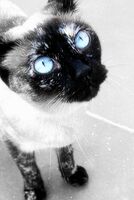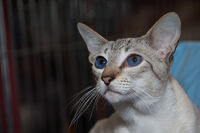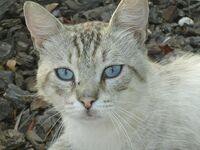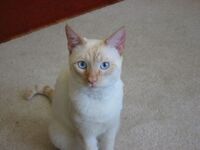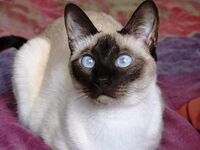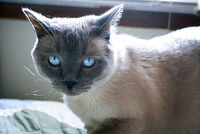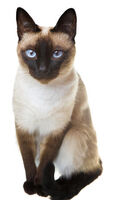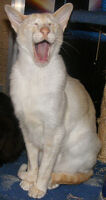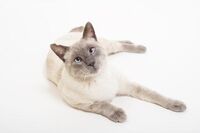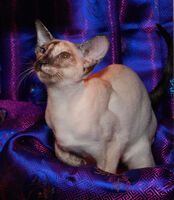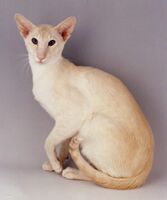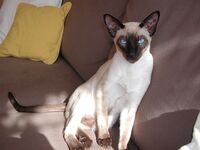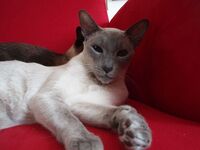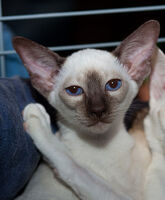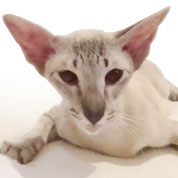| Siamese | ||
|---|---|---|
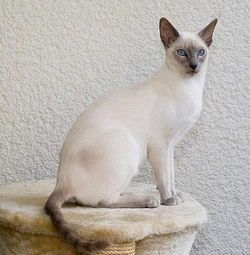 | ||
| Information | ||
| Alternative Names |
Wichien-moon (Moon diamond) | |
| Origin |
Thailand | |
| Breed Standard | ||
| CFA | ||
| TICA | ||
| AACE | ||
| ACF | ||
| ACF | ||
| CCA | ||
| Cat (Felis catus) | ||
| List of Cat Breeds | ||
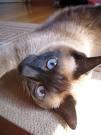
A Siamese
The Siamese (aka Moon-Diamond, Wichien-maat or วิเชียรมาศ) is a popular breed of cat.
History
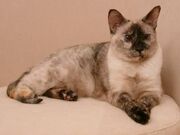
The first mention of Siamese was in Tamra Maew (Cat Poems) in the 1700s. In 1878, a Siamese Cat was a gift to American President Rutherford B. Hayes. Six years later it arrived in Britain as a gift from Edward Blencowe Gould to his sister Lilian Jane Veley, who later founded a Siamese Cat Club in 1901. In 1885 Lilian Jane Veley's Siamese named Pho and Mia had three Siamese kittens named Duen Ngai, Kalohom, and Khromata. The parents and kittens were show at London's Crystal Palace Cat Show, and they made a big impression. But, strangely, all three kittens died soon after the show. In 1886, more were imported meaning the Siamese craze was born.
Modern development
In the 1950s - 1960s, as the Siamese was increasing in popularity, many breeders and cat show judges began to favor the more slender look. As a result of generations of selective breeding, they created increasingly long, fine-boned, narrow-headed cats; eventually the modern show Siamese was bred to be extremely elongated, with lean, tubular bodies, long, slender legs, a very long, very thin tail that tapers gradually into a point and long, wedge-shaped heads topped by extremely large, wide-set ears. The minority of breeders who stayed with the original style found that their cats were no longer competitive in the show ring.
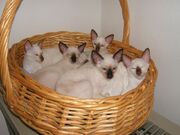
Modern Siamese kittens
By the mid-1980s, cats of the original style had disappeared from cat shows, but a few breeders, particularly in the UK, continued to breed and register them, resulting in today's two types of Siamese – the modern "show-style" Siamese, and the "traditional" Siamese, both descended from the same distant ancestors, but with few or no recent ancestors in common. In the late 1980s, breeders and fans of the older style of Siamese organised in order to preserve old, genetically healthy lines from extinction; educate the public about the breed's history; and provide information on where people could buy kittens of the more moderate type. Several different breeders' organisations have developed, with differing breed standards and requirements (such as whether or not cats must have documented proof of ancestry from an internationally recognised registry). Partially due to such disagreements, there are several different names used for the cats, including "Traditional Siamese", "Old Style Siamese", "Classic Siamese", and "Appleheads" (originally a derogatory nickname coined by modern-type Siamese breeders as an exaggerated description of less extremely wedge-shaped heads). [1] The International Cat Association (TICA), [2] in addition to the regular Siamese breed category in which modern show-style Siamese are shown, now accept a breed in the Preliminary New Breed Category called Thai,[3] similar to the Thaikatze which are seen in Europe. The TICA Thai is recognised, which includes Siameses of the less extreme type or a Wichien-Maat imported from Thailand. The Thai is also recognized by the World Cat Federation. Thai are the original type of cats from Thailand, brought to America on January 3, 1879 as a gift from the American consul in Bangkok to the President's wife, Mrs. Lucy Webb Hayes.
Description
Appearance
The breed standard of the Modern Siamese indicates an elegant, slim, stylish, flexible, and well- muscled body. Its head is triangular shaped, with a thin snout. The eyes are almond-shaped and oblique, with large wide based ears positioned more towards the side of the head. This positioning should form a perfect triangle from the tip of the nose to each tip of the ear. It has a long elegant neck, body, and whippy slender tail. The fur is short, glossy, fine, soft, tight, and adhered to the body with no undercoat. The Siamese is characterized by its typical pointed color scheme.
The pointed pattern is a form of partial albinism, resulting from a mutation in tyrosinase, an enzyme involved in melanin production. The mutated enzyme is heat-sensitive; it fails to work at normal body temperatures, but becomes active in cooler areas of the skin. This results in dark colouration in the coolest parts of the cat's body, including the extremities and the face, which is cooled by the passage of air through the sinuses.
All Siamese kittens, although pure cream or white at birth, develop visible points in the first few months of life in colder parts of their body. By the time a kitten is four weeks old, the points should be clearly distinguishable enough to recognise which colour they are. Siameses tend to darken with age, and generally, adult Siamese living in warm climates have lighter coats than those in cool climates. Originally the vast majority of Siamese had seal (extremely dark brown, almost black) points, but occasionally Siamese were born with blue (a cool grey) points, genetically a dilution of seal point; chocolate (lighter brown) points, a genetic variation of seal point; or lilac (pale warm gray) points, genetically a diluted chocolate.
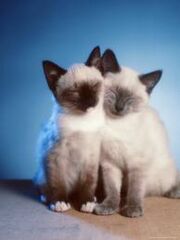
These colours were at first considered "inferior" seal points, and were not qualified for showing or breeding. All of these shades were eventually accepted by the breed associations, and became more common through breeding programmes specifically aimed at producing these colours. Later, outcrosses with other breeds developed Siamese-mix cats with points in other cat colours and patterns including Red and Cream point, lynx (tabby) point, and tortoise-shell ("tortie") point.
In the United Kingdom, all pointed Siamese-style cats are considered part of the Siamese breed. In the United States, the major cat registry, the Cat Fanciers' Association, considers only the four original colourations as Siamese: seal point, blue point, chocolate point, and lilac point. Oriental cats with colourpoints in colours or patterns aside from these four are considered Colorpoint Shorthairs in the American cat fancy.
Many Siameses from Thailand had a kink in their tails but over the years, this trait has been considered a flaw and breeders have largely eradicated it, although it persists among street cats in Thailand. Many early Siamese were cross-eyed to compensate for the abnormal uncrossed wiring of the optic chiasm, which is produced by the same albino allele that produces coloured points. Like the kinked tails, the crossed eyes have been seen as a fault and through selective breeding; the trait is far less common today.
The Thai shares some features with the Modern Siamese (e.g., the color pattern and the short single coat, although not so short and "painted on" as the modern) but differs from it in head and body type. It has a "foreign" type (rather elongated, high on the legs, lithe but substantial, with medium boning) not an "oriental" type as in the modern Siamese and Oriental breeds) and it has a modified wedge head, with rounded cheeks from which project a wedge shaped muzzle (or "marten face" as it was called in 19th century descriptions). The ears are moderately large but not huge, and are placed higher than those of the modern Siamese ears are. The eyes are medium to slightly large, a full almond shape but not extremely "oriental."
Temperament
Siamese are affectionate and very intelligent cats, renowned for their social nature. Many enjoy being with people and are sometimes described as "extroverts". As there are extroverts Siamese, some have very sensitive and nervous temperaments. Those individuals may not easily adapt to the changes of environment or to strangers. They do have a great need for human companionship. Often they bond strongly to a single person. Most Siamese like to have other sociable cats for company and do not thrive as only cats owned by people who are gone much of the day. Siamese are extremely vocal, with a loud, low-pitched voice – known as "Meezer", from which they get one of their nicknames – that has been compared to the cries of a human baby, and persistent in demanding attention. These cats are typically active and playful, even as adults, and are often described as more dog like in behavior than other cats.
The social orientation of Siameses may be related to their lessened ability to live independent of humans. Siamese coat colouration is appealing to humans, but is ineffective for camouflage purposes. They are less active at night than most cats, possibly because their blue eyes lack a tapetum lucidum, a structure which amplifies dim light in the eyes of other cats. The mutation in the tyrosinase also results in abnormal neurological connections between the eye and the brain.[4]
Unlike many other blue-eyed white cats, Siameses do not have reduced hearing ability. The deafness that sometimes occurs in completely white cats is a result of the genetics that causes the loss of pigment cells in the skin, which has nothing to do with the tyrosinase gene defect that causes Siamese color. Regardless, being dependent on humans may have been a survival trait for ancestors of the Siamese.
Points
- Seal Point - A dark brown color
- Chocolate Point A lighter brown color
- Blue Point - A dark grey color
- Lilac Point - A light grey color
- Flame Point - An orange color
- Cream Point - A cream color
- Tortie Point - Any one of the above colors with white spots Except for Flame and Cream
- Lynx Point - Any one of the above colors with stripes
- Cinnamon Point - A light Cinnamon color
- Fawn Point - A light grey color, even lighter than Lilac Point
Sub-points
Lynx
- Seal-Lynx Point
- Chocolate-Lynx Point
- Blue-Lynx Point
- Lilac-Lynx Point
- Flame-Lynx Point
- Cream-Lynx Point
Tortie
- Seal-tortie Point
- Chocolate-tortie Point
- Blue-cream Point
- Lilac-cream Point
Tortie-Lynx
- Seal-tortie Lynx Point
- Chocolate-tortie Lynx Point
- Blue-cream Lynx Point
- Lilac-cream Lynx Point
Gallery
Traditional
Modern
Breeds derived from the Siamese
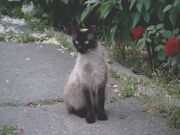
Adult female Balinese cat (siamese longhair)
- Balinese; a long haired Siamese. In the largest US registry, the Cat Fanciers Association (CFA), limited to the four traditional Siamese coat colours of seal point, blue point (a dilute of seal point), chocolate point, and lilac point (a dilute of chocolate point). Other registries in the US and worldwide recognise a greater diversity of colours.
- Burmese is a breed of domesticated cats descended from a specific cat, 'Wong Mau', who was found in Burma in 1930 by Dr. Joseph Cheesman Thompson. She was brought to San Francisco, California, where she was bred with Siamese. While technically not derived from Siamese, the breed was considered a form of Siamese for many years, leading to crossbreeding.
- Bombalese; an extremely new rare crossbreed of the Bombay and short-haired Siamese. They are limited to seal point, red point and black.
- Colorpoint Shorthair; a Siamese-type cat registered in CFA with pointed coat colours aside from the traditional CFA Siamese coat colours; originally developed by crosses with other shorthair cats. Considered part of the Siamese breed in all other cat associations, but considered a separate breed in CFA. Variations can include Lynx Points and Tortie Points.
- Himalayan - Longhaired breed originally derived from crosses of Persians to Siamese and pointed domestic longhair cats in order to introduce the point markings and the colours chocolate and lilac. After these initial crosses were used to introduce the colours, further breed development was performed by crossing these cats only to the Persian breed. In Europe, they are referred to as colourpoint Persians. In CFA, they are a colour division of the Persian breed.
- Javanese; a longhaired version of the Colorpoint Shorthair in CFA. In Europe, it is an obsolete term for the longhaired version of the Oriental Shorthair.
- Ocicat; a spotted cat originally produced by a cross between Siamese and Abyssinian.
- Oriental Shorthair – a Siamese-style cat in non-pointed coat patterns and colours, including solid, tabby, silver/smoke, and tortoise-shell.
- Oriental Longhair – a longhaired version of the Oriental Shorthair.
- Snowshoe; a cream and white breed with blue eyes and some points that was produced through the cross-breeding of the Siamese and bicoloured American Shorthair in the 1960s.
- Thai; also called the Wichien-Maat or Old Style Siamese, the original type of Siamese imported from Thailand in the 19th century and still bred in Thailand today; and throughout the first half of the 20th century, the only type of Siamese bred in the West.[5]
- Tonkinese; originally a cross between a Siamese and a Burmese. Tonkinese x Tonkinese matings can produce kittens with Burmese "sepia" pattern, Siamese "pointed" pattern, or a Tonkinese "mink" pattern which is something in between the two, with less pattern contrast than the Siamese but greater than the Burmese, and with aqua eyes.
See also
References
- ↑ Dr. Cris Bird. The Types of Siamese. Archived from the original on 1999-11-03. Retrieved on 2006-09-27.
- ↑ TICA. The International Cat Association. Retrieved on 2007-05-29.
- ↑ The International Cat Association. Thai Breed Standard. Retrieved on 9 September 2009.
- ↑ Journal / Book Citation
- ↑ Amy Rebeka. Thai Cat History. Retrieved on 2007-05-29.

